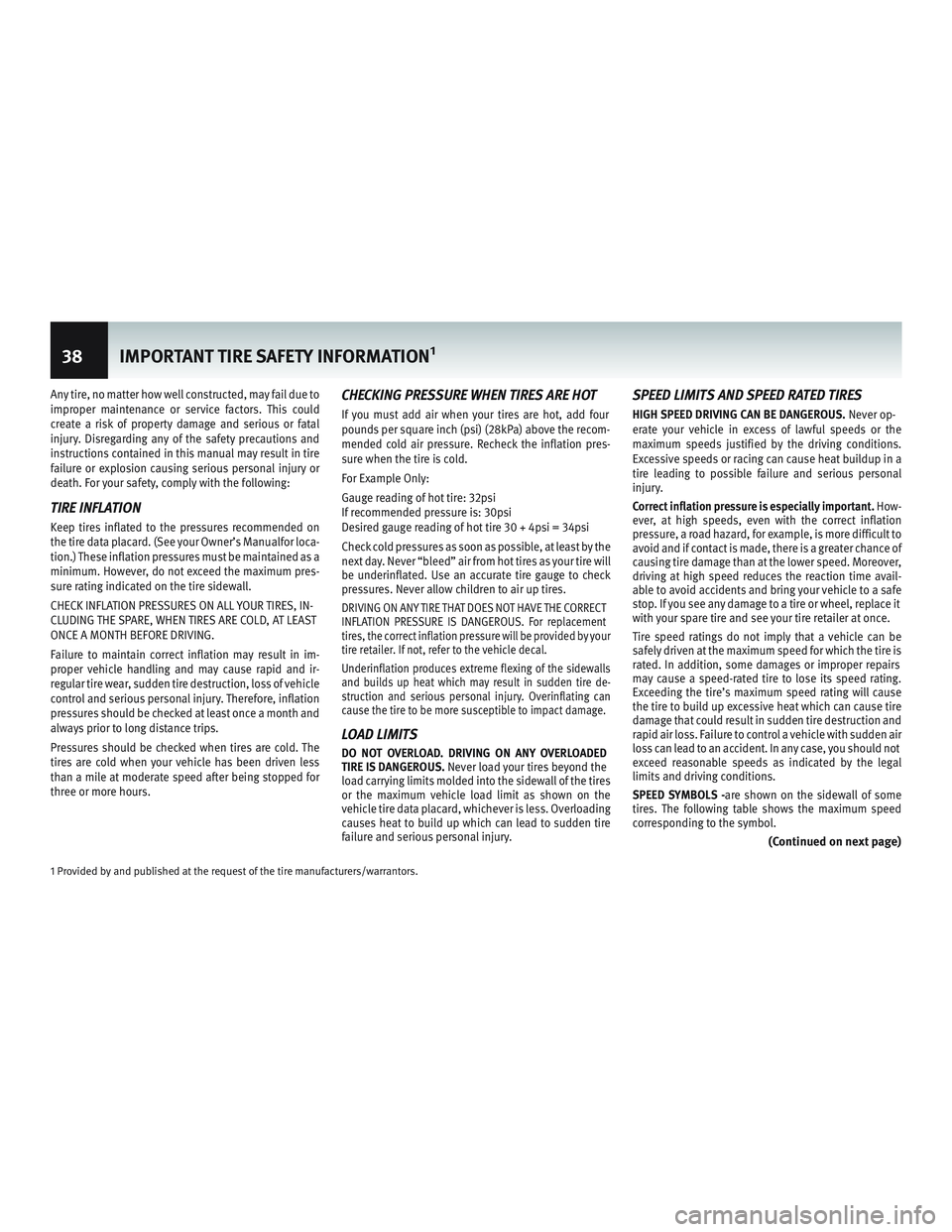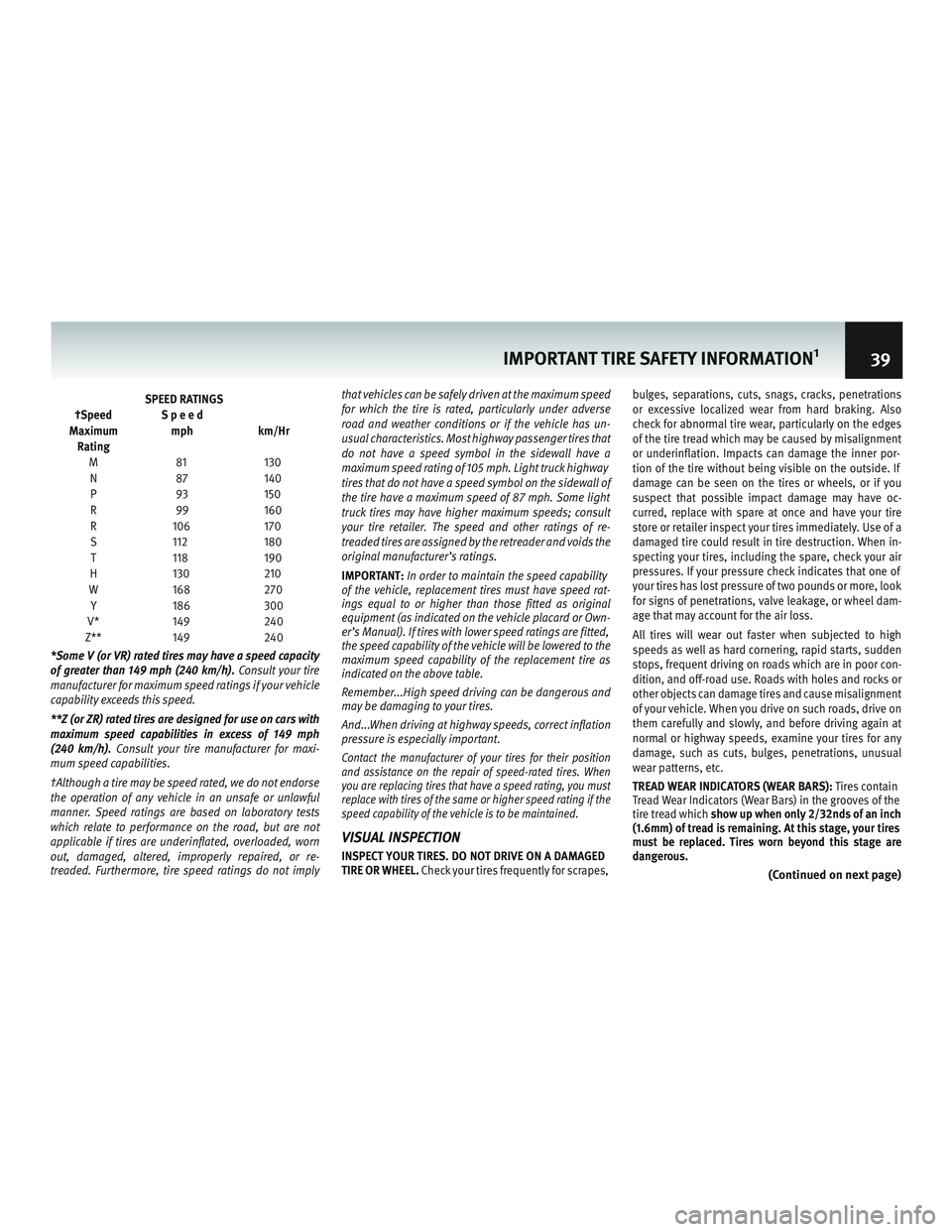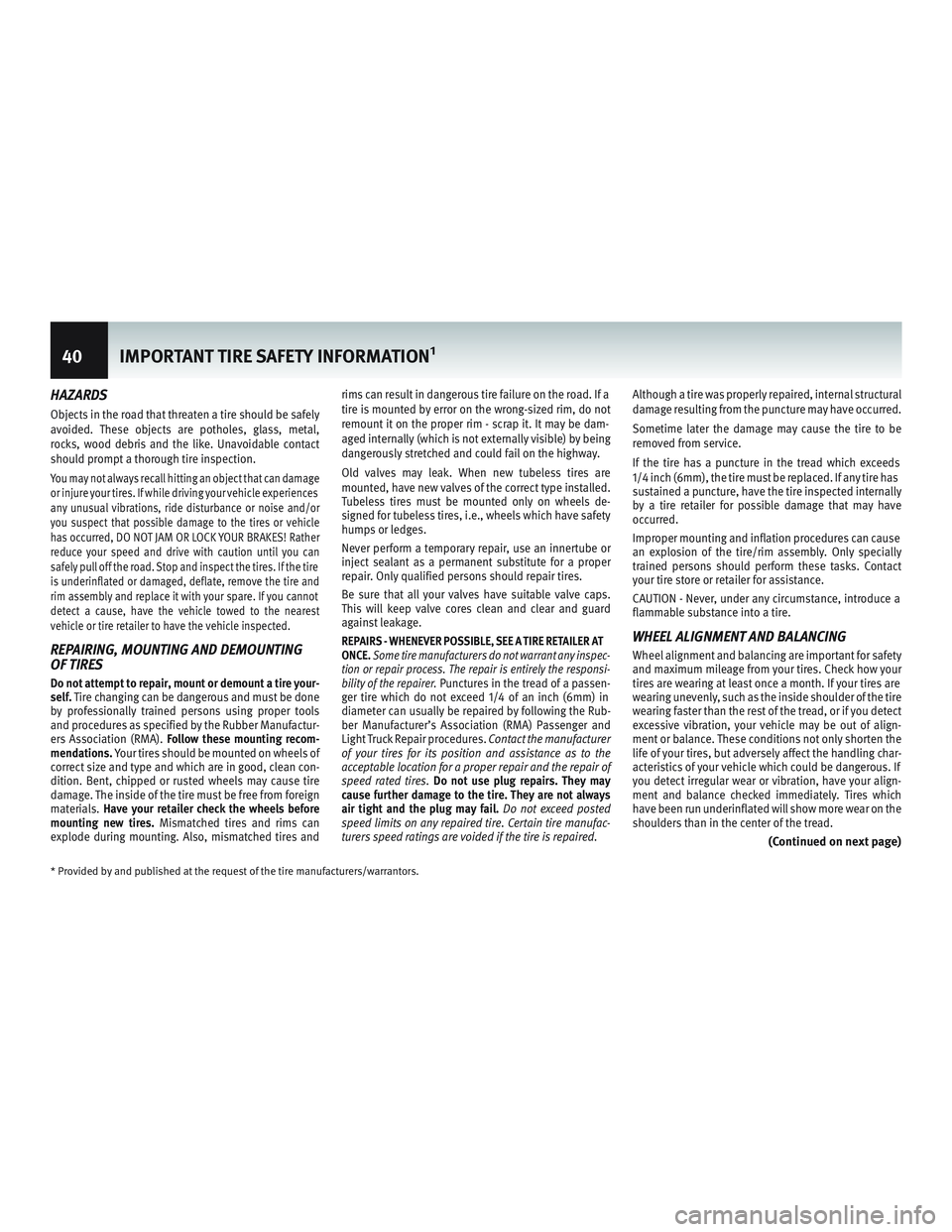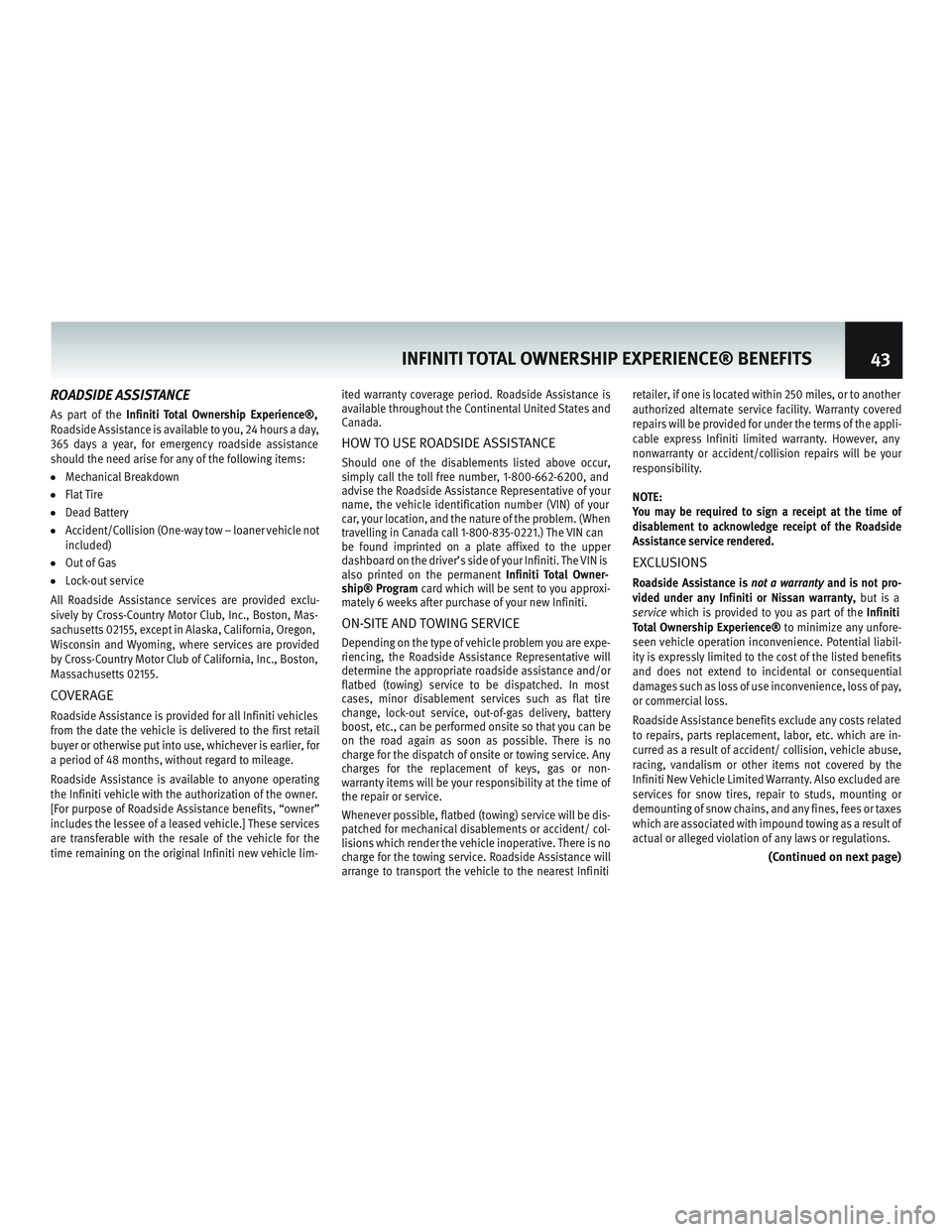ESP INFINITI QX60 2015 Warranty Information Booklet
[x] Cancel search | Manufacturer: INFINITI, Model Year: 2015, Model line: QX60, Model: INFINITI QX60 2015Pages: 51, PDF Size: 1.36 MB
Page 42 of 51

Any tire, no matter how well constructed, may fail due to
improper maintenance or service factors. This could
create a risk of property damage and serious or fatal
injury. Disregarding any of the safety precautions and
instructions contained in this m anual may result in tire
failure or explosion caus ing serious personal injury or
death. For your safety, comply with the following:
TIRE INFLATION
Keep tires inflated to the pressures recommended on
the tire data placard. (See your Owner’s Manualfor loca-
tion.) These inflation pressures must be maintained as a
minimum. However, do not exceed the maximum pres-
sure rating indicated on the tire sidewall.
CHECK INFLATION PRESSURES ON ALL YOUR TIRES, IN-
CLUDING THE SPARE, WHEN TIRES ARE COLD, AT LEAST
ONCE A MONTH BEFORE DRIVING.
Failure to maintain correct inflation may result in im-
proper vehicle handling and may cause rapid and ir-
regular tire wear, sudden tire destruction, loss of vehicle
control and serious personal injury. Therefore, inflation
pressures should be checked at least once a month and
always prior to long distance trips.
Pressures should be checked when tires are cold. The
tires are cold when your vehicle has been driven less
than a mile at moderate speed after being stopped for
three or more hours.
CHECKING PRESS URE WHEN TIRES ARE HOT
If you must add air when your tires are hot, add four
pounds per square inch (psi) (28kPa) above the recom-
mended cold air pressure. Recheck the inflation pres-
sure when the tire is cold.
For Example Only:
Gauge reading of hot tire: 32psi
If recommended pressure is: 30psi
Desired gauge reading of hot tire 30 + 4psi = 34psi
Check cold pressures as soon as possible, at least by the
next day. Never “bleed” air from hot tires as your tire will
be underinflated. Use an accurate tire gauge to check
pressures. Never allow children to air up tires.
DRIVING ON ANY TIRE THAT DOES NOT HAVE THE CORRECT
INFLATION PRESSURE IS DANGEROUS. For replacement
tires, the correct inflation pressure will be provided by your
tire retailer. If not, refer to the vehicle decal.
Underinflation produces extreme flexing of the sidewalls
and builds up heat which may result in sudden tire de-
struction and serious personal injury. Overinflating can
cause the tire to be more susceptible to impact damage.
LOAD LIMITS
DO NOT OVERLOAD. DRIVING ON ANY OVERLOADED
TIRE IS DANGEROUS. Never load your tires beyond the
load carrying limits molded into the sidewall of the tires
or the maximum vehicle load limit as shown on the
vehicle tire data placard, whichever is less. Overloading
causes heat to build up which can lead to sudden tire
failure and serious personal injury.
SPEED LIMITS AND SPEED RATED TIRES
HIGH SPEED DRIVING CAN BE DANGEROUS. Never op-
erate your vehicle in excess of lawful speeds or the
maximum speeds justified by the driving conditions.
Excessive speeds or racing can cause heat buildup in a
tire leading to possible f ailure and serious personal
injury.
Correct inflation pressure is especially important. How-
ever, at high speeds, ev en with the correct inflation
pressure, a road hazard, for example, is more difficult to
avoid and if contact is made, there is a greater chance of
causing tire damage than at the lower speed. Moreover,
driving at high speed reduces the reaction time avail-
able to avoid accidents and bring your vehicle to a safe
stop. If you see any damage to a tire or wheel, replace it
with your spare tire and see your tire retailer at once.
Tire speed ratings do not imply that a vehicle can be
safely driven at the maximum speed for which the tire is
rated. In addition, some damages or improper repairs
may cause a speed-rated tire to lose its speed rating.
Exceeding the tire’s maximum speed rating will cause
the tire to build up excessive heat which can cause tire
damage that could result in sudden tire destruction and
rapid air loss. Failure to control a vehicle with sudden air
loss can lead to an accident. In any case, you should not
exceed reasonable speeds as indicated by the legal
limits and driving conditions.
SPEED SYMBOLS -are shown on the sidewall of some
tires. The following table shows the maximum speed
corresponding to the symbol.
(Continued on next page)
1 Provided by and published at the request of the tire manufacturers/warrantors.
38IMPORTANT TIRE SAFETY INFORMATION1
Page 43 of 51

SPEED RATINGS
†Speed S peed
Maximum Rating mph km/Hr
M 81 130 N 87 140P 93 150
R 99 160
R 106 170
S 112 180 T 118 190
H 130 210
W 168 270 Y 186 300
V* 149 240
Z** 149 240
*Some V (or VR) rated tires may have a speed capacity
of greater than 149 mph (240 km/h). Consult your tire
manufacturer for maximum speed ratings if your vehicle
capability exceeds this speed.
**Z (or ZR) rated tires are designed for use on cars with
maximum speed capabilities in excess of 149 mph
(240 km/h). Consult your tire manufacturer for maxi-
mum speed capabilities.
†Although a tire may be speed rated, we do not endorse
the operation of any vehicle in an unsafe or unlawful
manner. Speed ratings are based on laboratory tests
which relate to performance on the road, but are not
applicable if tires are underinflated, overloaded, worn
out, damaged, altered, improperly repaired, or re-
treaded. Furthermore, tire speed ratings do not imply that vehicles can be safely driven at the maximum speed
for which the tire is rated, particularly under adverse
road and weather conditions or if the vehicle has un-
usual characteristics. Most highway passenger tires that
do not have a speed symbol in the sidewall have a
maximum speed rating of 105 mph. Light truck highway
tires that do not have a speed symbol on the sidewall of
the tire have a maximum speed of 87 mph. Some light
truck tires may have higher maximum speeds; consult
your tire retailer. The speed and other ratings of re-
treaded tires are assigned by the retreader and voids the
original manufacturer’s ratings.
IMPORTANT:
In order to maintain the speed capability
of the vehicle, replacement tires must have speed rat-
ings equal to or higher than those fitted as original
equipment (as indicated on the vehicle placard or Own-
er’s Manual). If tires with lower speed ratings are fitted,
the speed capability of the vehicle will be lowered to the
maximum speed capability of the replacement tire as
indicated on the above table.
Remember...High speed driving can be dangerous and
may be damaging to your tires.
And...When driving at highway speeds, correct inflation
pressure is especially important.
Contact the manufacturer of your tires for their position
and assistance on the repair of speed-rated tires. When
you are replacing tires that have a speed rating, you must
replace with tires of the same or higher speed rating if the
speed capability of the vehicle is to be maintained.
VISUAL INSPECTION
INSPECT YOUR TIRES. DO NOT DRIVE ON A DAMAGED
TIRE OR WHEEL. Check your tires frequently for scrapes, bulges, separations, cuts, snags, cracks, penetrations
or excessive localized wear from hard braking. Also
check for abnormal tire wear, particularly on the edges
of the tire tread which may be caused by misalignment
or underinflation. Impacts can damage the inner por-
tion of the tire without being
visible onthe outside. If
damage can be seen on the tires or wheels, or if you
suspect that possible impact damage may have oc-
curred, replace with spare at once and have your tire
store or retailer inspect your tires immediately. Use of a
damaged tire could result in tire destruction. When in-
specting your tires, including the spare, check your air
pressures. If your pressure check indicates that one of
your tires has lost pressure of two pounds or more, look
for signs of penetrations, valve leakage, or wheel dam-
age that may account for the air loss.
All tires will wear out faster when subjected to high
speeds as well as hard cornering, rapid starts, sudden
stops, frequent driving on roads which are in poor con-
dition, and off-road use. Roads with holes and rocks or
other objects can damage tires and cause misalignment
of your vehicle. When you drive on such roads, drive on
them carefully and slowly, and before driving again at
normal or highway speeds, examine your tires for any
damage, such as cuts, bulges, penetrations, unusual
wear patterns, etc.
TREAD WEAR INDICATORS (WEAR BARS): Tires contain
Tread Wear Indicators (Wear Bars) in the grooves of the
tire tread which show up when only 2/32nds of an inch
(1.6mm) of tread is remaining. At this stage, your tires
must be replaced. Tires worn beyond this stage are
dangerous.
(Continued on next page)
IMPORTANT TIRE SAFETY INFORMATION139
Page 44 of 51

HAZARDS
Objects in the road that threaten a tire should be safely
avoided. These objects arepotholes, glass,metal,
rocks, wood debris and the like. Unavoidable contact
should prompt a thorough tire inspection.
You may not always recall hitting an object that can damage
or injure your tires. If while driving your vehicle experiences
any unusual vibrations, ride disturbance or noise and/or
you suspect that possible damage to the tires or vehicle
has occurred, DO NOT JAM OR LOCK YOUR BRAKES! Rather
reduce your speed and drive with caution until you can
safely pull off the road. Stop and inspect the tires. If the tire
is underinflated or damaged, deflate, remove the tire and
rim assembly and replace it with your spare. If you cannot
detect a cause, have the vehicle towed to the nearest
vehicle or tire retailer to have the vehicle inspected.
REPAIRING, MOUNTING AND DEMOUNTING
OF TIRES
Do not attempt to repair, mount or demount a tire your-
self. Tire changing can be dangerous and must be done
by professionally trained persons using proper tools
and procedures as specified by the Rubber Manufactur-
ers Association (RMA). Follow these mounting recom-
mendations. Your tires should be mounted on wheels of
correct size and type and which are in good, clean con-
dition. Bent, chipped or rusted wheels may cause tire
damage. The inside of the tire must be free from foreign
materials. Have your retailer check the wheels before
mounting new tires. Mismatched tires and rims can
explode during mounting. Also, mismatched tires and rims can result in dangerous tire failure on the road. If a
tire is mounted by error on the wrong-sized rim, do not
remount it on the proper rim - scrap it. It may be dam-
aged internal
ly (which is not extern ally visible) by being
dangerously stretched and could fail on the highway.
Old valves may leak. When new tubeless tires are
mounted, have new valves of the correct type installed.
Tubeless tires must be mounted only on wheels de-
signed for tubeless tires, i.e., wheels which have safety
humps or ledges.
Never perform a temporary repair, use an innertube or
inject sealant as a permanent substitute for a proper
repair. Only qualified persons should repair tires.
Be sure that all your valves have suitable valve caps.
This will keep valve cores clean and clear and guard
against leakage.
REPAIRS - WHENEVER POSSIBLE, SEE A TIRE RETAILER AT
ONCE. Some tire manufacturers do not warrant any inspec-
tion or repair process. The repair is entirely the responsi-
bility of the repairer.
Punctures in the tread of a passen-
ger tire which do not exceed 1/4 of an inch (6mm) in
diameter can usually be repaired by following the Rub-
ber Manufacturer’s Association (RMA)Passenger and
Light Truck Repair procedures. Contact the manufacturer
of your tires for its position and assistance as to the
acceptable location for a proper repair and the repair of
speed rated tires. Do not use plug repairs. They may
cause further damage to the tire. They are not always
air tight and the plug may fail. Do not exceed posted
speed limits on any repaired tire. Certain tire manufac-
turers speed ratings are voided if the tire is repaired. Although a tire was properly repaired, internal structural
damage resulting from the puncture may have occurred.
Sometime later the damage may cause the tire to be
removed from service.
If the tire has a puncture in the tread which exceeds
1/4 inch (6mm), the tire must be replaced. If any tire has
sustained a puncture, have the tire inspected internally
by a tire retailer for possible damage that may have
occurred.
Improper mounting and inflation procedures can cause
an explosion of the tire/rim assembly. Only specially
trained persons should perform these tasks. Contact
your tire store or retailer for assistance.
CAUTION - Never, under any c
ircumstance, introduce a
flammable substance into a tire.
WHEEL ALIGNMENT AND BALANCING
Wheel alignment and balancing are important for safety
and maximum mileage from your tires. Check how your
tires are wearing at least once a month. If your tires are
wearing unevenly, such as the inside shoulder of the tire
wearing faster than the rest of the tread, or if you detect
excessive vibration, your vehicle may be out of align-
ment or balance. These conditions not only shorten the
life of your tires, but adversely affect the handling char-
acteristics of your vehicle which could be dangerous. If
you detect irregular wear or vibration, have your align-
ment and balance checked immediately. Tires which
have been run underinflated will show more wear on the
shoulders than in the center of the tread.
(Continued on next page)
* Provided by and published at the request of the tire manufacturers/warrantors.
40IMPORTANT TIRE SAFETY INFORMATION1
Page 47 of 51

ROADSIDE ASSISTANCE
As part of theInfiniti Total Ownership Experience®,
Roadside Assist ance is available to you, 24 hours a day,
365 days a year, for emer gency roadsideassistance
should the need arise for any of the following items:
●Mechanical Breakdown
●Flat Tire
●Dead Battery
●Accident/Collision (One-way tow – loaner vehicle not
included)
●Out of Gas
●Lock-out service
All Roadside Assist ance services are provided exclu-
sively by Cross-Country Motor Club, Inc., Boston, Mas-
sachusetts 02155, except in Alaska, California, Oregon,
Wisconsin and Wyoming, where services are provided
by Cross-Country Motor Club of California, Inc., Boston,
Massachusetts 02155.
COVERAGE
Roadside Assistance is provided for all Infiniti vehicles
from the date the vehicle is delivered to the first retail
buyer or otherwise put into use, whichever is earlier, for
a period of 48 months, without regard to mileage.
Roadside Assistance is available to an yone operating
the Infiniti vehicle with the authorization of the owner.
[For purpose of Roadside Assist ance benefits, “owner”
includes the lessee of a leased vehicle.] These services
are transferable with the resale of the vehicle for the
time remaining on the original Infiniti new vehicle lim- ited warranty coverage period.
Roadside Assistance is
available throughout the Continental United States and
Canada.
HOW TO USE ROADSIDE ASSISTANCE
Should one of the disablements listed above occur,
simply call the toll free number, 1-800-662-6200, and
advise the Roadside Assistance Representative of your
name, the vehicle identification number (VIN) of your
car, your location, and the nature of the problem. (When
travelling in Canada call 1-800-835-0221.) The VIN can
be found imprinted on a plate affixed to the upper
dashboard on the driver’s side of your Infiniti. The VIN is
also printed on the permanent Infiniti Total Owner-
ship® Program card which will be sent to you approxi-
mately 6 weeks after purchase of your new Infiniti.
ON-SITE AND TOWING SERVICE
Depending on the type of vehicle problem you are expe-
riencing, the R oadside Assistance Represent ative will
determine the appropriate roadside assistance and/or
flatbed (towing) service to be dispatched. In most
cases, minor disablement services such as flat tire
change, lock-out service, out-of-gas delivery, battery
boost, etc., can be performed onsite so that you can be
on the road again as soon as possible. There is no
charge for the dispatch of onsite or towing service. Any
charges for the replacement of keys, gas or non-
warranty items will be your responsibility at the time of
the repair or service.
Whenever possible, flatbed (towing) service will be dis-
patched for mechanical disablements or accident/ col-
lisions which render the vehicle inoperative. There is no
charge for the towing service. Roadside Assistance will
arrange to transport the vehicle to the nearest Infiniti retailer, if one is located within 250 miles, or to another
authorized alternate service facility. Warranty covered
repairs will be provided for under the terms of the appli-
cable express Infiniti limited warranty. However, any
nonwarranty or accident/collision repairs will be your
responsibility.
NOTE:
You may be required to sign a receipt at the time of
disablement to acknowledge receipt of the Roadside
Assistanc
e service rendered.
EXCLUSIONS
Roadside Assistance is not a warrantyand is not pro-
vided under any Infiniti or Nissan warranty, butisa
service which is provided to you as part of the Infiniti
Total Ownership Experience® to minimize any unfore-
seen vehicle operation inconvenience. Potential liabil-
ity is expressly limited to the cost of the listed benefits
and does not extend to incidental or consequential
damages such as loss of use inconvenience, loss of pay,
or commercial loss.
Roadside Assistance benefits exclude any costs related
to repairs, parts replacement, labor, etc. which are in-
curred as a result of accident/ collision, vehicle abuse,
racing, vandalism or other items not covered by the
Infiniti New Vehicle Limited Warranty. Also excluded are
services for snow tires, repair to studs, mounting or
demounting of snow chains, and any fines, fees or taxes
which are associated with impound towing as a result of
actual or alleged violation of any laws or regulations.
(Continued on next page)
INFINITI TOTAL OWNERSHIP EXPERIENCE® BENEFITS 43